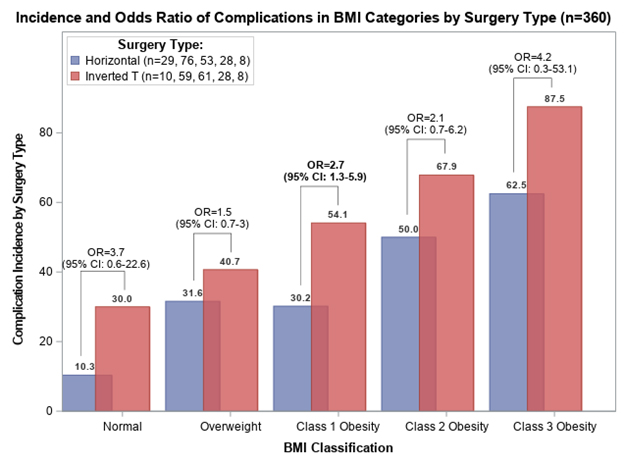Institutional and TOPS analysis of Different Abdominal Lipectomy Technique Complications
Ahmed Mansour, Zara Butte, Hope Kincaid, Sean Wallace, Nathan Miller, Yee Cheng Low, Marshall Miles, Randolph Wojcik, Robert Murphy
Lehigh Valley Health Network, Allentown, PA
BACKGROUND: An evaluation of complication rates in different abdominal lipectomy techniques with relationship to BMI and other risk factors.
PURPOSE: To compare complication rates of horizontal and inverted-T abdominal lipectomy patients with BMI and identify other risk factors to better assist surgical decision making and in establishing best practices.METHODS: We identified patients who underwent an abdominal lipectomy without concurrent hernia repair at our institution from January 2015-July 2020. Patients were classified into two groups: 1. Horizontal lipectomy with/without umbilical translocation 2. Inverted-T lipectomy. Demographics, operative details, and post-operative complications were collected for 1 year postoperatively. Bivariate analyses were conducted. Crude and stratum-specific (based on BMI) odds ratios (ORs) for complications were calculated for the inverted-T compared to the horizontal group. A replicate analysis using the American Society of Plastic Surgeons (ASPS) Tracking Operations and Outcomes for Plastic Surgeons (TOPS) registry is currently being performed as well.
RESULTS: At our institution, 362 patients (group 1=196, group 2=166) met inclusion criteria. 40.9% of patients experienced at least one complication. Wound disruption rates were higher for inverted-T group (39.8%) compared to horizontal group (16.3%) (p<0.0001). The odds of experiencing a complication were greater in the inverted-T group overall and within each stratum of BMI (Fig. 1). At this time, the TOPS analysis has not been finalized but approximately 30,000 patients will be included.Factors associated with complications included BMI (p<0.0001), tobacco use (p=0.0176), diabetes (p=0.0281), ASA (p<0.0001), prior massive weight loss (p=0.0050), and LOS (p=0.0004). When dividing the cohort based on BMI class (normal weight, overweight, class I, class II, and class III obesity), the incidence of wound disruption increased as did BMI (2.6%, 22.2%, 27.2%, 48.2%, and 56.3%, respectively, p<0.0001). Hospital re-admission rate was also higher in the class III obesity group (31.3%, p=0.0238).
DISCUSSION: Inverted-T lipectomies had more than twice the odds of a complication compared to a horizontal lipectomy. The implications of more aggressive surgery with regards to subsequent wound care, quality of life and cost are profound. A comparison of these findings with the forthcoming results of the TOPS analysis could provide significant insight in selection of the appropriate technique and establishment of best practices in the realm of aesthetic and reconstructive abdominal contouring.
CONCLUSIONS: Inverted-T lipectomies had higher rates of complications than horizontal lipectomies, regardless of BMI class. Higher BMI was also associated with higher complication rates. TOPS can provide population level findings to suggest best practices.
Back to 2022 Posters

